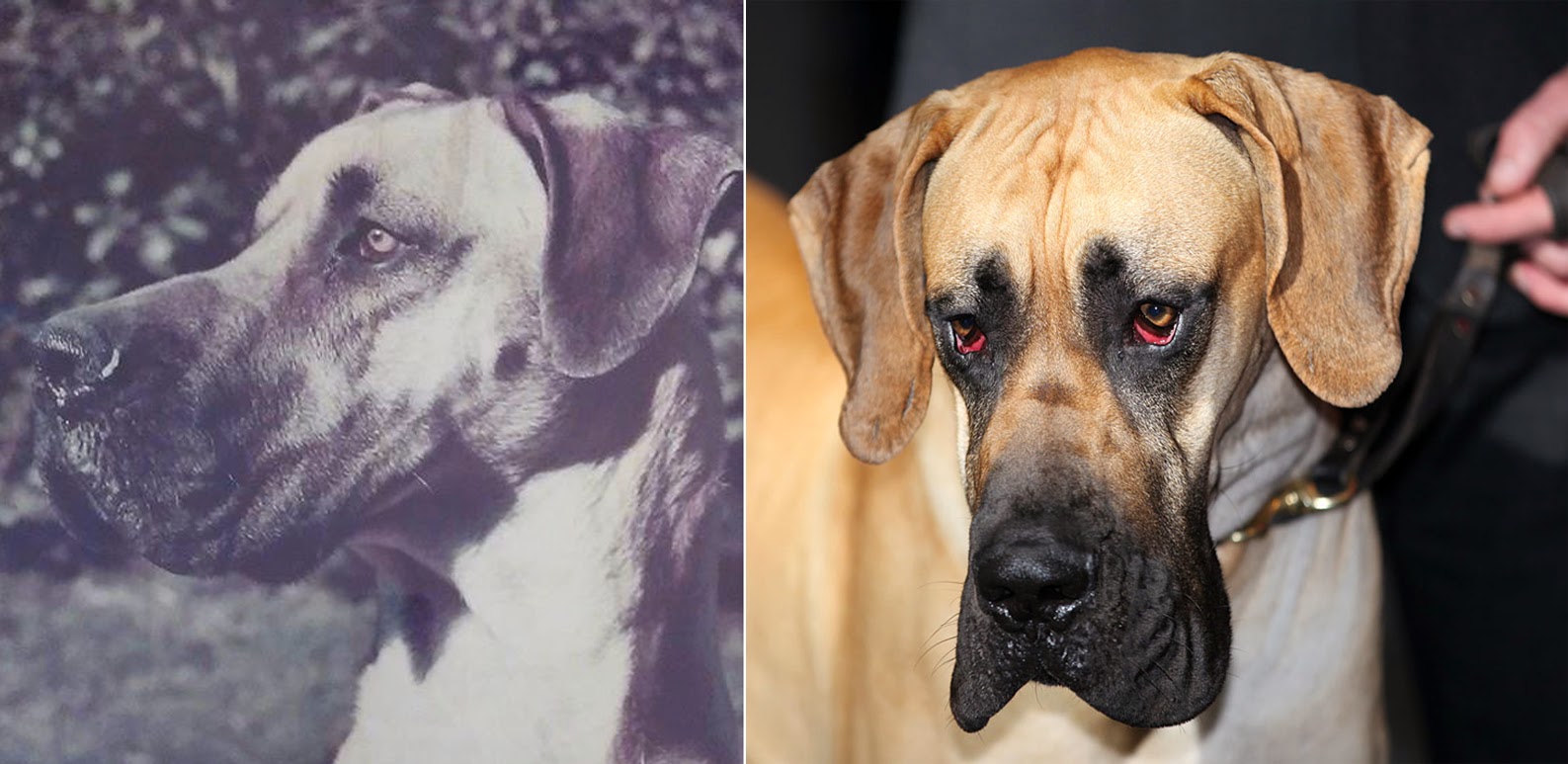The two line-drawings at the top are taken from British Dogs, Their Points, Selection, And Show Preparation by W.D Drury, published in 1903. They formed part of the Great Dane breed standard adopted by the Great Dane Club (UK) at the time. The two pictures underneath are of modern show dogs (on the left, UK; on the right a French champion).
One hundred years ago, the breed looked like this...
 |
| b.1899 |
Can anyone truly think that this is any kind of an improvement on the dog of 100 years ago?
In France, particularly, the rise of what's often called the Euro-Dane is turning the breed into a Neapolitan Mastiff - a grotesque, floppy-flewed caricature of what the breed used to be.
 |
| Better body... but who on earth thought that head was a good idea? |
This is not just an aesthetic issue. Floppy flews are dysfunctional. There is no benefit to a bigger/heavier ear leather. Over-sized bodies elevate the risk of joint issues. Many Dane eyes are wincingly painful, too - both for the dogs and for any observer not subsumed into a breed culture that makes them oblivious to the every-second-of-the-waking-day discomfort dogs like this endure.
 |
| UK showdog |
 |
| UK showdog |
I continue to be at a loss as to why poor longevity in Danes and many other breeds doesn't trigger a massive effort by Kennel Clubs and breeders to do something to tackle it. Instead, breeders seem to claim it as some kind of breed feature, something they accept as one of those things; not their fault... not much they can do about it.
This is not true. They can do something about it.
I have a soft spot for Danes because I grew up with two of them. Neither of them were any great shakes. One had a digestive problem that kept him rake thin. The other was a nice-but-dim-Tim who died young of a reason lost in time. This is me with him when he was a pup at a fun dog-show in the 1970s (we came second in the dog-with-the-longest-tail class).
Here's another beautiful Dane head from the 1970s compared to a modern UK show dog.
Many of today's Great Danes are a disgrace, with mostly no purpose other than to be an oversized, slobbery mess. They are a travesty of what they used to be.
Here's one of the reasons why... take a look at the points system that was in place for many years in the UK. Although no longer used in the UK, it helped set the agenda. Most important? The head and the size. Least important, less so even than the tail or feet? Overall condition.
Want to know what do to do about it?
• international breed database that records health data and is open to all
• make death reporting (age and cause) a priority
• store semen when dogs are young and use it if they prove to be healthy into later years
• revise the points system (where still in use) to make condition/activity more important.
• rewrite the breed standard to reduce the minimum weight; introduce a maximum height and weight.
• worldwide symposium aimed at uniting breeders in a breed conservation plan
• breed them smaller. As with many giant breeds, there has been a creeping increase in size. Today's Danes are massive - much bigger than they used to be.
Big dogs die young. Bigger dogs die younger.
And bigger dogs with deep chests die even younger.
(The bloat situation is so bad in the breed that many breeders and owners do a pre-emptive gastropexy.)
This is also, perhaps, where the new International Partnership for Dogs (IPFD) could play a role. If every signed-up KC contributed pictures of their top-winning dogs every year, the side-by-side comparisons would alert to the different types, prompting discussion that would hopefully help reign in excess.
Additionally, in the UK, the Kennel Club now needs to make this breed a Category Three breed - one whose conformation demands urgent action.
To finish with an eye-cleanser, I should say that there are still some nice show Danes around - this is the Dane that took Best of Breed at Westminster this year. The dog is too big, and his neck is too long, but the WKC winner is much more moderate than some of the travesties we are seeing on this side of the pond.
And how about this... a Dane in the Finnish show-ring. Beautiful - and pretty typical of the breed in Finland; a country so often ahead of the rest of the world when it comes to the health of purebred dogs.
So let's see more of them.. and a lot less of these.
 |
| © Falkhor Babinosaure |
 |
| © Falkhor Babinosaure |








